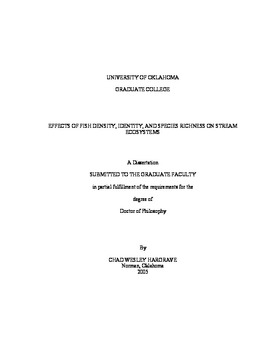| dc.contributor.advisor | Matthews, William J., | en_US |
| dc.contributor.author | Hargrave, Chad Wesley. | en_US |
| dc.date.accessioned | 2013-08-16T12:19:45Z | |
| dc.date.available | 2013-08-16T12:19:45Z | |
| dc.date.issued | 2005 | en_US |
| dc.identifier.uri | https://hdl.handle.net/11244/849 | |
| dc.description.abstract | Stream ecosystem properties and functions are important because they provide services such as water purification, oxygen production, and carbon fixation that help sustain life. Aquatic organisms can affect these properties and functions through different pathways linked to a species trophic and functional characteristics. It is necessary to understand how these ecosystem effects vary among taxa because as aquatic biota change as a result of random, natural, or anthropogenic influences, ecosystems properties and functions are likely to be affected. | en_US |
| dc.description.abstract | This research suggests that the population size, the identity of species in the assemblage, as well as the number of species making up the assemblage can be important factors affecting stream ecosystem properties and functions. Chapters 1--3 were conducted in artificial stream mesocosms, and may have limited applicability to natural stream ecosystems where a variety of abiotic factors can influence ecosystems. In Chapter 4, I tested the ecosystem effects of three fish species from different functional groups on PPR, benthic algae biomass (as chlorophyll-a), and benthic invertebrate density in a natural stream ecosystem using field enclosures. Treatments were Blackstripe Topminnow (Fundulus notatus), a surface insectivore; Longear Sunfish (Lepomis megalotis), a watercolumn insectivore; Orangethroat Darter (Etheostoma spectabile), a benthic invertivore; and a fishless control. Primary productivity was greater in all enclosures with fish than in enclosures without fish. Relative to control enclosures, benthic algae biomass was not different in Blackstripe Topminnow treatments, but was greater in Longear Sunfish treatments on both sample days, and was greater in Orangethroat Darter treatments on day 15. Benthic invertebrate abundance was not affected by any of the fish treatments. These data agree with results from previous mesocosm experiments. Thus, despite the limited realism of stream mesocosms, patterns observed in mesocosm experiments are likely to occur in natural stream ecosystems. (Abstract shortened by UMI.) | en_US |
| dc.description.abstract | Fishes are important consumers in stream ecosystems, having important regulatory roles for many ecosystem properties and functions. In this dissertation, I addressed the effects of fishes on stream ecosystems from three perspectives. I asked (1) if fish ecosystem effects were dependent on local fish density, (2) if fish effects were caused by different species-specific food web pathways, and (3) if co-occurring fish species had facilitative effects on ecosystems when in more specious assemblages. | en_US |
| dc.format.extent | xvi, 125 leaves : | en_US |
| dc.subject | Agriculture, Fisheries and Aquaculture. | en_US |
| dc.subject | Biotic communities. | en_US |
| dc.subject | Biology, Ecology. | en_US |
| dc.subject | Fishes Speciation. | en_US |
| dc.subject | Stream animals. | en_US |
| dc.title | Effects of fish density, identity, and species richness on stream ecosystems. | en_US |
| dc.type | Thesis | en_US |
| dc.thesis.degree | Ph.D. | en_US |
| dc.thesis.degreeDiscipline | Department of Biology | en_US |
| dc.note | Adviser: William J. Matthews. | en_US |
| dc.note | Source: Dissertation Abstracts International, Volume: 66-02, Section: B, page: 0674. | en_US |
| ou.identifier | (UMI)AAI3163015 | en_US |
| ou.group | College of Arts and Sciences::Department of Biology | |
